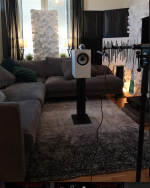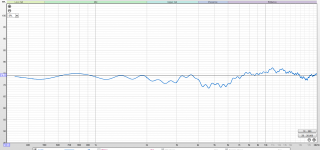So I just got home a calibrated umik-1 microphone with an idea of changing crossover or something with my B&W 705 s2.
Current crossover is a 4,3 uf capacitor and a 4,5mH inductor giving me hipass of 4625, and a low pass of 285 first orders.
Measured approximatly 70cm away from speaker on axis on tweeter.
Is this worth fiddeling with, judging the 3,3ms timegated measurment?
- Terms of soundquality it can sound quite harsh, especially at higher volumes
Current crossover is a 4,3 uf capacitor and a 4,5mH inductor giving me hipass of 4625, and a low pass of 285 first orders.
Measured approximatly 70cm away from speaker on axis on tweeter.
Is this worth fiddeling with, judging the 3,3ms timegated measurment?
- Terms of soundquality it can sound quite harsh, especially at higher volumes
Attachments
Last edited:
You are likely mistaken about the LP inductor value. Try to increase the time window to about 10ms and record the response 1m away and change the frequency scale to logarithmic. Simple filters are always a good opportunity to sharpen skills furher to make it sound more accurate and refined.
hey, could be - will attatch some images
Wouln't 10ms pretty much include alot of room in the measurments, pretty much by 3,3ms i get my first reflection
Wouln't 10ms pretty much include alot of room in the measurments, pretty much by 3,3ms i get my first reflection
Forgot to add there is some sort of filmcap in the mixaswell, it pretty sure it goes on the tweeter , likely a safe circuit?? anyway here is 1m , 3ms IR and logarithmic 🙂
Attachments
An air-cored low resistance 4.5mH inductor would be huge. I mean a stack of pancakes size. 😱 I suspect you are looking at .45mH.
It's not quite the huge HF peak that Soundstage measured though is it? Still the HF are running a little hot. Two or 3ohm of series resistance in front of the tweeter might help. But it's also possible that the harshness is just a characteristic of the tweeter. I would expect better though from B&W but maybe I'm mistaken.
It's not quite the huge HF peak that Soundstage measured though is it? Still the HF are running a little hot. Two or 3ohm of series resistance in front of the tweeter might help. But it's also possible that the harshness is just a characteristic of the tweeter. I would expect better though from B&W but maybe I'm mistaken.
An air-cored low resistance 4.5mH inductor would be huge. I mean a stack of pancakes size. 😱 I suspect you are looking at .45mH.
It's not quite the huge HF peak that Soundstage measured though is it? Still the HF are running a little hot. Two or 3ohm of series resistance in front of the tweeter might help. But it's also possible that the harshness is just a characteristic of the tweeter. I would expect better though from B&W but maybe I'm mistaken.
Oh, I see .45 looks good on vituixcad, thanks
Forgot to add there is some sort of filmcap in the mixaswell, it pretty sure it goes on the tweeter , likely a safe circuit??
No, it is a 1R high end resistor that appears to be a Powertron model. When you get the will to study B&W loudspeaker service manuals, you will realize that there is more speakers that share this "less is more" crossover approach.
No, it is a 1R high end resistor that appears to be a Powertron model. When you get the will to study B&W loudspeaker service manuals, you will realize that there is more speakers that share this "less is more" crossover approach.
THat would have made this so much easier knowing they exists.... there looks to even be diagrams out there... on the crossovers..
- Home
- Loudspeakers
- Multi-Way
- Measurment - B&W 705 s2







